Marketo Fragments Explained: Best Use Cases for Education Industry
If you’ve been using Marketo for a while, you know how time-consuming it can be to manage dozens of emails and landing pages across different campuses, courses, and audiences. Small updates like changing a footer or updating event details can quickly turn into hours of manual work.
That’s where Fragments come in...
Before we dive into use cases, let’s quickly clear up how fragments differ from snippets and tokens:
✳️ Tokens are placeholders for values (like {{lead.First Name}} or {{my.WebinarDate}}). They personalize or automate content at the field level, but they don’t carry design or layout.
✳️ Snippets are small, reusable content blocks usually text or simple HTML — that you can drop into emails and landing pages. They’re handy for things like disclaimers or repeated messages, though they have limited formatting flexibility.
✳️ Fragments go a step further. They’re reusable content modules that work in emails. Unlike snippets, they can include images, text, buttons, and layouts, and they can be made dynamic so different segments see different content.
In short, tokens handle personalized data, snippets handle lightweight reusable text, and fragments handle scalable, design-rich modules.
For marketers, fragments are a game-changer. Let’s look at some real-time use cases.
1. Campus-Specific Footers
Universities often have multiple campuses. Instead of building separate emails for each one, you can create a dynamic fragment that automatically pulls in the correct campus address, phone number, or map link.
• Example: A Sydney student sees “Sydney Campus | 111 George Street,” while a Melbourne student sees “Melbourne Campus | 999 Collins Street.”
• One email, one template, two tailored experiences.
2. Course Highlights Section
Prospective students want to know why a particular program is worth choosing. Instead of cloning multiple emails, create a fragment for “Top Reasons to Study This Course.”
• Business students see career outcomes in finance and consulting.
• Psychology students see opportunities in counseling and research.
• Nursing students see placements in hospitals and clinics.
You maintain one template, but each audience gets relevant content.
3. Compliance and Disclaimers
Educational institutions have strict compliance requirements like including CRICOS codes for international students in Australia or accreditation details for specific programs.
By using a fragment, you can ensure these critical statements are always up to date. If regulations change, you update the fragment once, and it automatically updates across every email that uses it.
4. Events and Information Sessions
Information Sessions campaigns are notorious for complexity multiple dates, venue or links, and activities across campuses or through online link. Instead of creating dozens of emails, you can:
• Use a branded header or hero image fragment that stays consistent.
• Dynamically update body content with campus-specific details.
• Change “Register Now” CTAs in one place, and see the update roll out everywhere.
This saves hours of manual editing and ensures a consistent student experience.
5. Domestic vs. International Messaging
The needs of domestic and international students are very different. Domestic students want to hear about local tuition and scholarships, while international students are more interested in visas, accommodation, and cultural support.
With dynamic fragments, you can handle both in a single email:
• Domestic students automatically see content tailored to them.
• International students see completely different information, without you having to create separate campaigns.
Benefits Recap
1. Efficiency: Update once, apply everywhere.
2. Consistency: Keep branding, compliance, and tone aligned.
3. Scalability: Manage hundreds of programs without duplicating effort.
4. Personalization: Deliver content that feels relevant without multiplying assets.
Getting Started with Fragments
If you’re new to fragments, start small:
👉 Turn your footer or header into a fragment.
👉 Create a clear naming convention so your team can find and reuse fragments easily.
👉 Experiment with dynamic fragments to see how much time you can save while improving personalization.
Final Thoughts
Marketing in education industry is complex — multiple campuses, countless programs, and diverse student audiences. Marketo fragments help simplify that complexity by making your campaigns scalable, consistent, and personalized.
If you’ve been relying on snippets or cloning assets, it’s time to take a closer look at fragments. They’re more than just a technical feature, they’re a smarter way to communicate with students, save your team time, and deliver a seamless brand experience across every touchpoint.
About the Author:
Sant Singh Rathaur is a digital strategist and marketing technologist who writes about the intersection of AI, human behaviour, and marketing technology. He brings a unique perspective on how emerging tech can empower human creativity and strategic thinking in the digital era.

Leave a Reply